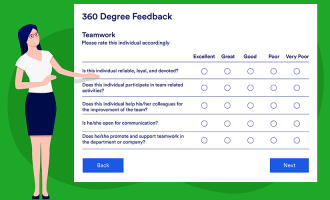In the world of sports, it’s easy to quantify success.
Quarterbacks get touchdowns.
Runners come in first.
Soccer players score goals.
Boxers deliver knockouts.
But for most of us, assessing whether we’re doing a good job at work isn’t so straightforward.
Perhaps that’s why performance reviews are so fraught — both for employees and employers.
According to a survey conducted by Mercer, only two percent of companies believe their performance management process delivers “exceptional value.” Less than three percent find their feedback practices to be excellent.
By any measure, these are terrible statistics.
Performance appraisals are meant to evaluate employees, of course. But done well, they can also achieve much more. Effective reviews provide employees with clear insight into how they can grow, but also how they’re valuable to the larger goals of the company. This, in turn, leads to higher employee engagement. When workers are engaged, they’re more likely to stay at their jobs.
Many companies, like Google, are delaying their performance reviews for six months, until Covid-19 is hopefully under control. Facebook is giving all its employees an extra $1,000 in their next paychecks, along with a universal “exceeds expectations” review.
Whether your company is delaying performance reviews or not, the current global crisis means that now is an especially good time to give real thought to your employees’ worth and ensure they know that they’re supported. After all, just because performance reviews are tricky to get right doesn’t mean that feedback isn’t valuable. It’s just a matter of doing it well.
The problem with traditional performance reviews

Where to begin?
As Samuel Culbert, a professor of management and organizations at UCLA’s Anderson School of Management, put it bluntly in an op-ed at the Wall Street Journal, reviews are “a negative to corporate performance, an obstacle to straight-talk relationships, and a prime cause of low morale at work.”
One of the major issues with the annual performance review is that, well, it’s annual. This means much of the feedback that managers offer is often no longer relevant — criticism unnecessarily rehashes past actions and praise feels like an afterthought.
Another is that most managers aren’t actually trained to evaluate performance, leading to awkward exchanges that leave employees feeling like they’re talking to a totally different person than the one they’re used to working with.
Performance reviews also tend to be inflexible, with no variation between age groups like millennials, who prefer more frequent feedback, versus baby boomers, who prefer less.
There are also problems with race and gender prejudices: A study at the University of Colorado found that executives who are women and people of color that push for other women and people of color to be hired suffer when it comes to their own reviews. (Meanwhile, white men are actually rewarded for doing the same thing.)
And these annual bombardments don’t do any favors for our mental health, either. Not only can they trigger panic attacks, but people undergoing reviews are found to have the same neural response as they would when confronted with a physical threat, like a run-in with a wild animal. Such a reaction is hardly conducive for any sort of thoughtful dialogue that allows people to really learn from a performance review.
Fixing the system

The bad news is that there is no one-size-fits-all solution to performance reviews. That said, there are some strategies that can make the experience more pleasant and effective across the board.
1. Create a schedule
Every company — large or small — should have a formalized schedule in place for reviews. This allows managers to set clear expectations, as well as allow for appropriate preparation on both the side of management and employees. This will look different for large corporations versus small businesses—smaller organizations can use a less structured process without risking overlooking anyone or giving any single employee too much attention.
Having a schedule doesn’t necessarily mean it has to be incredibly detailed. On the formal end, you can schedule benchmarks for measuring employee performance; a more relaxed set-up could mean simply scheduling the review and asking your teams to prepare accordingly.
2. Simplify feedback
Somewhere along the line, systems for evaluating employee contributions became really complicated. For managers, assessing multiple criteria like “met budget goals” and “collaborated well with others” translates to more questions to ask and answer, and ultimately, stacks of forms to submit to HR. For employees, competing directives can result in feelings of confusion about how to use the evaluation to actually improve at their jobs.
Streamlining performance reviews to be more flexible and relevant to the work being done has been a popular solution for both managers and employees.

One simple way to do this is by using digital forms — Jotform makes this easy by offering a suite of customizable templates suitable for multiple types of evaluations. These forms allow managers to create questions relevant to individual roles, distribute them via email or app, and compile the information so everyone on the review team can access it quickly and easily.
3. Find the frequency sweet spot
If performance reviews are so stressful, it might be tempting to think it’s best to limit them to once a year. But Gallup found that weekly check-ins are five times more likely to produce meaningful feedback and that employees are three times more likely to feel engaged at work as a result.
The strategy of frequent check-ins has been adopted by many companies, like Deloitte, Accenture, Microsoft, IBM and PwC. By some estimates, more than a third of U.S. companies have abandoned annual assessments in favor of regular, more casual discussions.
Deloitte began using weekly check-ins as part of its radical overhaul of the annual review process. These brief conversations offer micro-doses of what traditional assessments cram into one yearly session. Team leaders have a weekly opportunity to set expectations for the coming week, provide feedback, and review priorities. As Marcus Buckingham and Ashley Goodall wrote for Harvard Business Review, if managers check in less than once a week, it becomes harder for them to give constructive coaching on what’s coming up, forcing them to focus instead on past performance.
“In other words,” they write, “the content of these conversations will be a direct outcome of their frequency: If you want people to talk about how to do their best work in the near future, they need to talk often.”
While studies have shown that more frequent feedback can improve employee learning and task performance, there’s also a limit to its effectiveness. If feedback becomes overwhelming for employees, it can actually reduce learning and performance.
Obviously, employees have a greater appetite for receiving praise than criticism. The important thing for managers is to make sure that feedback — both positive and negative — is delivered in a way that’s clear and relevant.
Remember also that both supervisors and subordinates should feel comfortable asking for and giving feedback, which fosters a sense of trust between them. Jotform offers hundreds of ready-made feedback templates that companies can customize as they see fit, making it easy for employees to communicate their thoughts to management.
Ultimately, every employer is going to have to find a feedback strategy that works for them and their team. By organizing ahead of time, simplifying the process, and delivering feedback in a clear and actionable way, both managers and subordinates can walk away feeling satisfied.

















































































Send Comment: